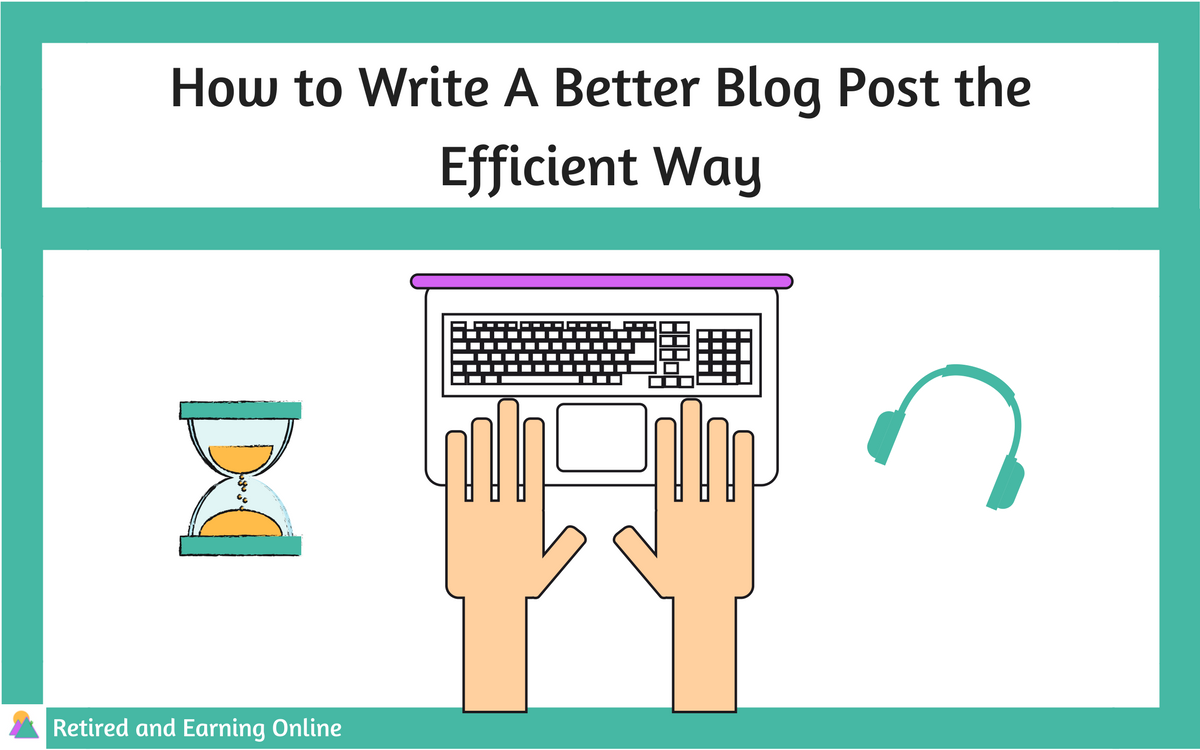You’ve had those days when the words just dry up, right?
Most things get easier with experience but even after blogging for more than a year, I’m always eager to read productivity tips, and I’ve tried most of them. I love my blogging life and the liberating experience of working from home on my schedule.
But….
All that freedom can occasionally lead to procrastination. I can’t sit back and wait for creativity to strike. I need a more proactive strategy to ensure I stay on track with my deadlines, publish premium content, and still achieve the proper work-life balance.
If you’re looking for a stress-buster routine that can really make a difference, let’s jump right into the details.
Steps to Improve Your Blogging Efficiency
Most things work better with a plan and a workflow strategy. Ultimately, you need to devise an approach that works well for you because we’re all different. But here are some suggestions to jumpstart your planning process that have worked well for me.
Step 1 – Identify Your Topic or “Seed Idea.”
I like to set aside time each week to do nothing but keyword research so that I always have at least 5 to 6 ideas in the hopper to select from. Few things are more stressful than publishing a post and not knowing where you’re going next. The day before each writing session, I make my current selection from the list.
As part of the research process, I create a new note in Evernote for each keyword and gather reference materials like articles I want to read, or sources I intend to use as external links. I’ll also check youtube to see if there’s an appropriate video to embed.
I can then quickly review my background materials as part of my selection process because it’s all very accessible, but I resist the urge to start writing at this point. Although, I do like to have a pretty clear image of the purpose of the post and what I want readers to take away from it.
Step 2 – Let Your Chosen Topic Simmer
I know generally what I’m going to blog about and I now tuck the idea away in the back of my mind, walk away, and go about my life. What I’ve noticed is that my subconscious gets ahold of the concept and works on it. This is especially true if I indulge in a little relaxation (golf works for me
Thoughts will pop into my head at unexpected moments, and I will jot them down as soon as I can because I lose these little gems just as quickly as they came to me. But I do have a favorite new tool for capturing this stuff anywhere. I downloaded Google Docs to my iPhone, and the voice recognition feature is awesome!
Step 3 – Eliminate Distractions That Can Sidetrack the Process
When It’s time to sit down at the keyboard, I want my environment to be as distraction-free as I can make it. I put my phone on airplane mode and turn off email notifications. Sometimes I’ll put on soft music to use as white noise but nothing with lyrics. I don’t want to find myself singing along.
Step 4 – Focus! I Like the Pomodoro Technique
The Pomodoro technique is a fun and deceptively simple method for encouraging immersion in a task for intervals of time. You set a timer and work full out on one thing for 25-minutes. When the timer dings, you take a 5-minute break before jumping back into your next session.
It sounds silly, but it does boost productivity! It’s a fabulous reminder that when I’m writing, I can’t do anything else until I hear the buzzer.
Intrigued? Here’s a video that more fully explains the technique.
Step 5 – Always Begin With A Simple Outline
What are the main points you want to convey in your article? Get off to a good start by creating headings and subheadings for these points. One advantage is that you’re less likely to forget anything. But the biggest benefit I’ve found is that I don’t have to follow some rigid structure.
Your post will ultimately have an intro or lead-in, several paragraphs where you make critical points, and then finish with a conclusion. But you don’t have to write it in that order and build it one sentence at a time. If you’ve broken it up into individual segments with their own subheadings, you’re free to complete the sections in any order you choose.
In fact, I recommend you leave the introduction for last. Get the meat of the post sorted out first. Then go back, and I think you’ll find the lead-in will flow more easily. We often struggle to get that intro just right, and it can chew up more time than expected.
Finally getting it right can feel a lot more satisfying if it’s the final step in the process. On the other hand, if you start with the introduction and spin your wheels it can feel like you have a long way to go.
Step 6 – Write Without Censuring or Editing Your Work
This step remains my biggest challenge, but with practice, I’m making progress. If you can just get the key points down without worrying about stuff like spelling, typos, grammar or anything else you can fix it later. It’s not necessary to agonize over every word choice as you create your first draft.
It’s a lot easier to pare down and revise once you have a draft to work with. So just start typing and see where it takes you.
Step 7 – Review and Use Editing Tools
There are some excellent tools for writing today that can help enormously to spruce up your draft and get it ready for your viewers. Grammarly is a must-have for me. It’s like having the luxury of a proofreader. The grammar police will be happy, and more importantly, your readers will thank you.
Step 8 – Paste the Document into the WordPress Editor and Get It Internet Ready
Working directly in the WordPress editor is possible but too distracting. If you create your post in a simple text editor like Google Docs, it’s easier to focus on your core message and just getting the words down. You also have a copy of all of your content, and you’re less likely to inadvertently publish too soon.
Perhaps the biggest advantage of waiting to place your content in WordPress is that you’re not tempted to continuously interrupt your writing to format or “make it pretty.” Write first and then focus on the visual aspects of your post. I’m in no way suggesting this aspect isn’t important, but it is a distinct element of the process that can be attacked separately.
Internet browsers are visual, so you’ll want to enhance your text by sprinkling images or perhaps adding a relevant video. Don’t forget to make your post scannable by using heading tags to call attention to your section subheadings. No giant paragraphs, please! Your readers’ eyes will glaze over, and you’ll lose them.
This is also the point in the process where you’ll add your internal and external links. And last but certainly not least, be sure to add your call to action.
Step 9 – Review Yoast SEO and Readability Status
I’m a huge fan of Yoast SEO for ensuring that my posts are properly optimized for the search engines. If you haven’t tried this plugin yet, you really should check it out. This is the stage where I add my meta description and tags and check for my SEO and readability green lights.
Step 10 – Preview Post, Read It One More Time and Click Publish
I always preview my post before I publish. There’s something about seeing my article in its finished format that draws the eye to anything that looks amiss. Maybe the spacing isn’t quite right, or there’s a heading I forgot to bold. Hopefully, the fixes are very quick at this stage.
It’s always a thrill to finally click that publish button, isn’t it?
Will Your Blog Post Be Perfect?
Probably not!
Here’s another blogging secret I’ve learned. I’ve labored over a post for a week that didn’t fare as well with the search engines as one I whipped out in a couple of hours. So, perfection may be somewhat overrated.
Following a strategy can help us to be productive on purpose rather than letting it happen by chance (or not!). We know that keeping to a schedule and blogging consistently has positive benefits. By following this flow, I don’t let procrastination get the better of me.
Wrapping Up
These 10 steps have been instrumental in helping me improve my work habits and increase my blogging frequency. Learning how to write a blog post the efficient way has also saved me time and made the entire process far less intimidating and stressful.
I mean, is there anything worse than staring at a blank screen with no idea what to write?
If you’ve ever been there, as I have, I think you’ll agree it’s pretty bad. My hope is that some or all of my procedures will resonate with you and make your blogging life a little easier and more productive.
Over To You
So, what do you think of this approach? Do you have suggestions for me that I’m not using? Please drop me a line below because I would love to hear them!
Be Sociable
Do you know someone who’s started blogging that might find value in these tips?
Like It? Please Share It!




Thanks for a great article on writing. I have to say it was just what I needed to read. I constantly struggle with writing my posts for my blog. Because I’m not a natural writer I find every excuse possible why there is something more important to do than write. I like the sound of the Pomodoro Technique. I think I’ll give it a shot. Thanks
Hi Hollie,
I hope the Pomodoro technique works as well for you as it has for me. Once I set that timer, it’s time to write until I hear the buzzer. It’s been a good motivational tool. Good luck with it!
Hi Linda,
Thanks a lot for this information. Personally, these steps have proved to be very helpful. I normally find myself wondering just how to start my next post and even which keyword to use. You have indeed taught me just how I can do all these things step by step and I’m so grateful.
I love the idea of writing down any information that comes across my mind and I found very valuable for my blogging.
For sure writing an efficient blog is not an easy thing at all. Being able to write something that will catch the attention of your visitors requires a lot of preparation and good planning like you said.
I know that all who read your post will find it very informative and helpful for their blogging.
Thanks so much for this information.
Hey Stephen,
I’m delighted I could help by sharing some strategies that have really helped me. I too started out without a well-thought out approach. Sometimes I got lucky because I got a timely inspiration but there were too many days when I wasted time staring at a blank screen without enough direction.
Breaking the process down into separate steps is incredibly efficient because you perform different types of tasks at each stage. You can tackle the larger job in smaller chunks and see progress which motivates you to keep going and stay on track.
Develop a routine and then strive to make to make it a new habit. Good luck and thanks for your very positive comments!
Ooh, I had never heard of the Pomodoro Technique but I’m gonna use that tonight when I start writing again!!!
Writing from the hip is something I’ve come to be very good at. Almost something that I’ve gotten sloppy with because I don’t like to read over my stuff too much.
But this is a great article that will help me greatly with my approach to writing.
Thanks for sharing!
Blessings,
Mike Jay
Hi Mike,
Glad I could help. I hope you’ll pop back and let me know how the Pomodoro technique works out for you. Most of us find the review and editing portion of the job to be our least favorite. It’s also extremely difficult to spot your own errors once you’ve made them. But, of course, we know that Google and the other search engines are very concerned with quality. So we want to avoid getting too sloppy. That’s where good writing tools can make all the difference.
Thank you for visiting my site and jumping in with feedback. Good luck with your blog!
It is hard for me always to get started with my work as a blogger due to lack of pre-preparation like keeping my books and my jottings ready before hand, but coming to your site today has opened my eyes to the importance of it. I will start today to get myself ready before indulging myself in the main business of writing.
Thanks for your article.
Hi Bibian,
I think most bloggers initially have unrealistic expectations of being able to sit down and crank out an article on demand. I know I did. I hope at least a few elements of my routine will help you increase your productivity levels and fine-tune a strategy that works well for you. Good luck!
Hi Linda
I’ve used all sorts of methods to produce blog content, and it always comes down to “just doing it”. I use most of your techniques for writing blog posts, but no matter how hard I try, I can seldom write a post without editing it on the way. It takes longer that way, but for blog posts, I like editing (or my best shot at editing) and formatting as I go.
I’ve always kept a list of “topics” to write about in things like Excel, notepad, and even in some keyword tools, but now I use a free task reminder, that seems to be working out so far. It’s TODOom at http://www.todoom.org
Many times when I have an idea for a post, I will have a stream of ideas about what I could write about in the post, and I just sorta list those ideas with the KW phrase in TODOom.
There’s a lot to do with a website, but without content it’s nothing, right? I like this article to make writing blog posts as efficient as possible.
Thanks
Hi Mike,
I think you’ve said it well. A website is all about quality content. It’s easy to get caught up with a lot of other aspects to your site like choosing a different theme or social media marketing. But it really is critical to keep our focus on creating those blogs that interest our readers. Thanks for the tool suggestion. I haven’t heard about TODOom before, but I’m going to head over and try it out. Anything that helps keep me organized and on task is a good thing!
Good luck with your site and thanks for chiming in!